SIT216: Maintaining Cyber Security Guidelines Report, University Name
VerifiedAdded on 2023/04/08
|10
|1902
|227
Report
AI Summary
This report examines the crucial aspects of maintaining cyber security guidelines in the context of increasing reliance on digital technology and the evolving nature of cyber threats. It begins by defining cyber security and emphasizing the necessity of guidelines to protect systems from vulnerabilities. The report then delves into current trends, such as managing unmanaged devices, addressing memcached vulnerabilities, and the growing importance of IoT security and cyber security insurance. It also outlines various cyber security guidelines and standards, including those from ETSI and ISO/IEC, and discusses the challenges of staying ahead of rapidly changing threats and the internal security risks. The justification for maintaining these guidelines is presented, along with the benefits, which include certifications, transparency, and improved security planning. The conclusion reinforces the need for updated guidelines and a proactive approach to cyber security to safeguard organizations and individuals in the digital age.
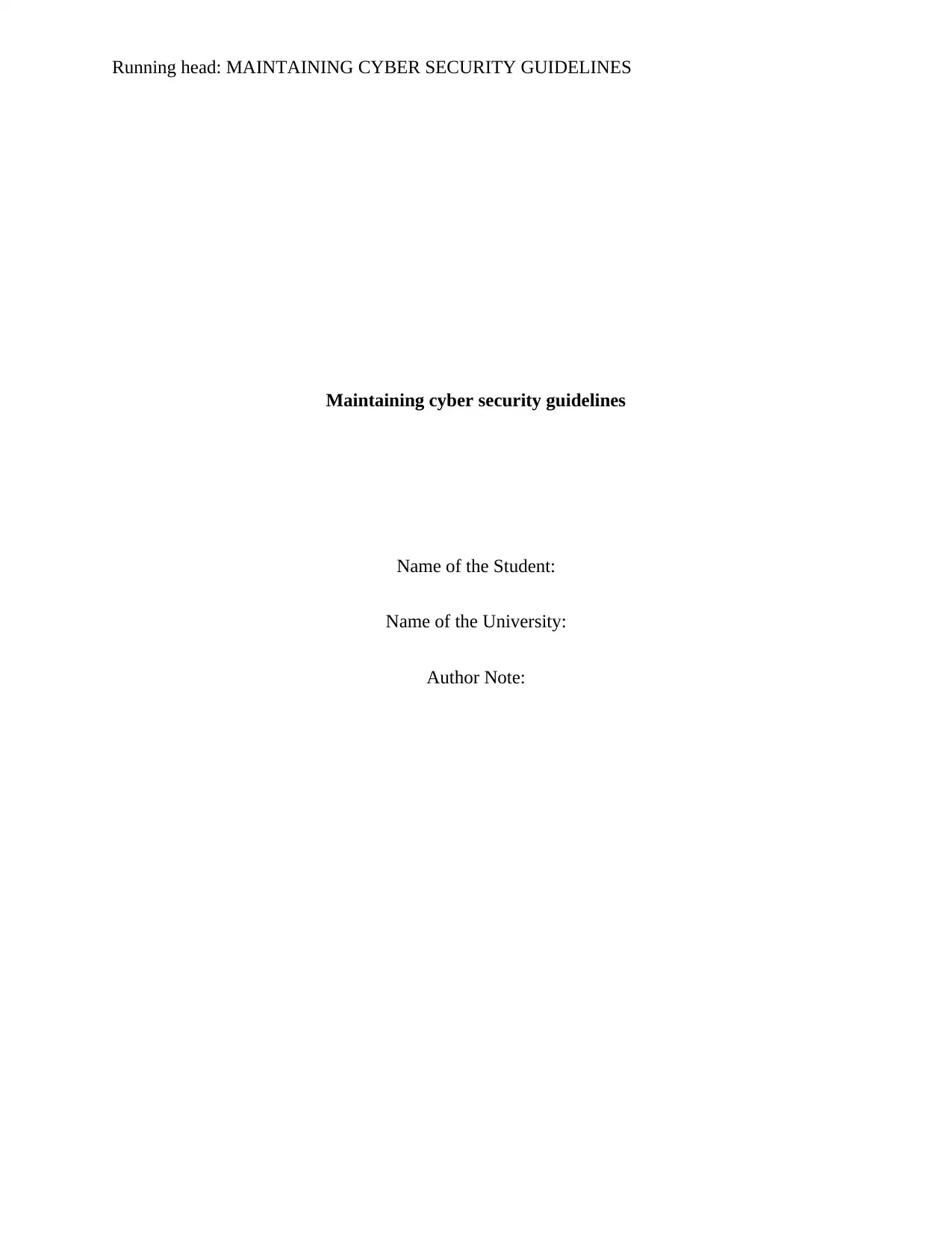
Running head: MAINTAINING CYBER SECURITY GUIDELINES
Maintaining cyber security guidelines
Name of the Student:
Name of the University:
Author Note:
Maintaining cyber security guidelines
Name of the Student:
Name of the University:
Author Note:
Paraphrase This Document
Need a fresh take? Get an instant paraphrase of this document with our AI Paraphraser
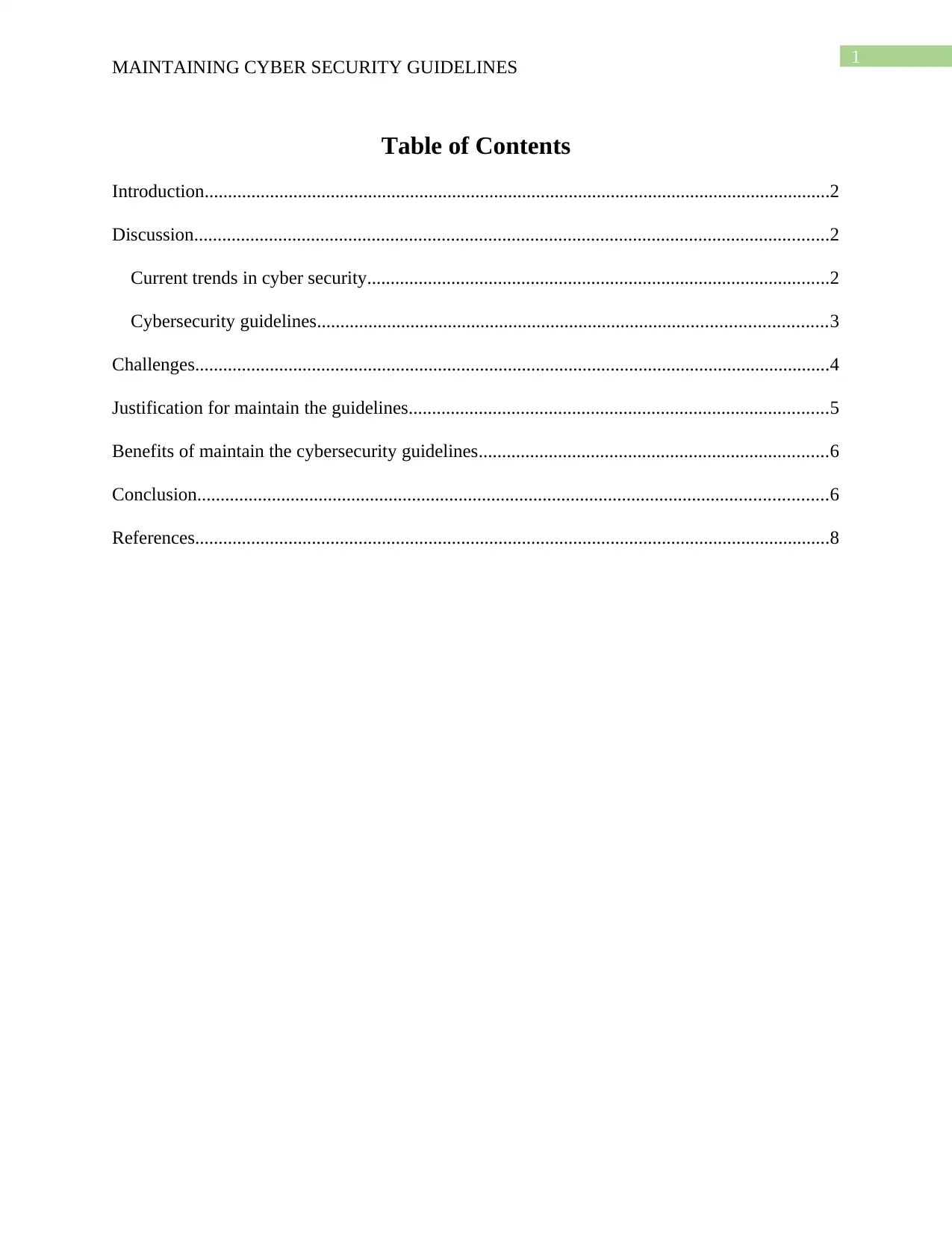
1
MAINTAINING CYBER SECURITY GUIDELINES
Table of Contents
Introduction......................................................................................................................................2
Discussion........................................................................................................................................2
Current trends in cyber security...................................................................................................2
Cybersecurity guidelines.............................................................................................................3
Challenges........................................................................................................................................4
Justification for maintain the guidelines..........................................................................................5
Benefits of maintain the cybersecurity guidelines...........................................................................6
Conclusion.......................................................................................................................................6
References........................................................................................................................................8
MAINTAINING CYBER SECURITY GUIDELINES
Table of Contents
Introduction......................................................................................................................................2
Discussion........................................................................................................................................2
Current trends in cyber security...................................................................................................2
Cybersecurity guidelines.............................................................................................................3
Challenges........................................................................................................................................4
Justification for maintain the guidelines..........................................................................................5
Benefits of maintain the cybersecurity guidelines...........................................................................6
Conclusion.......................................................................................................................................6
References........................................................................................................................................8
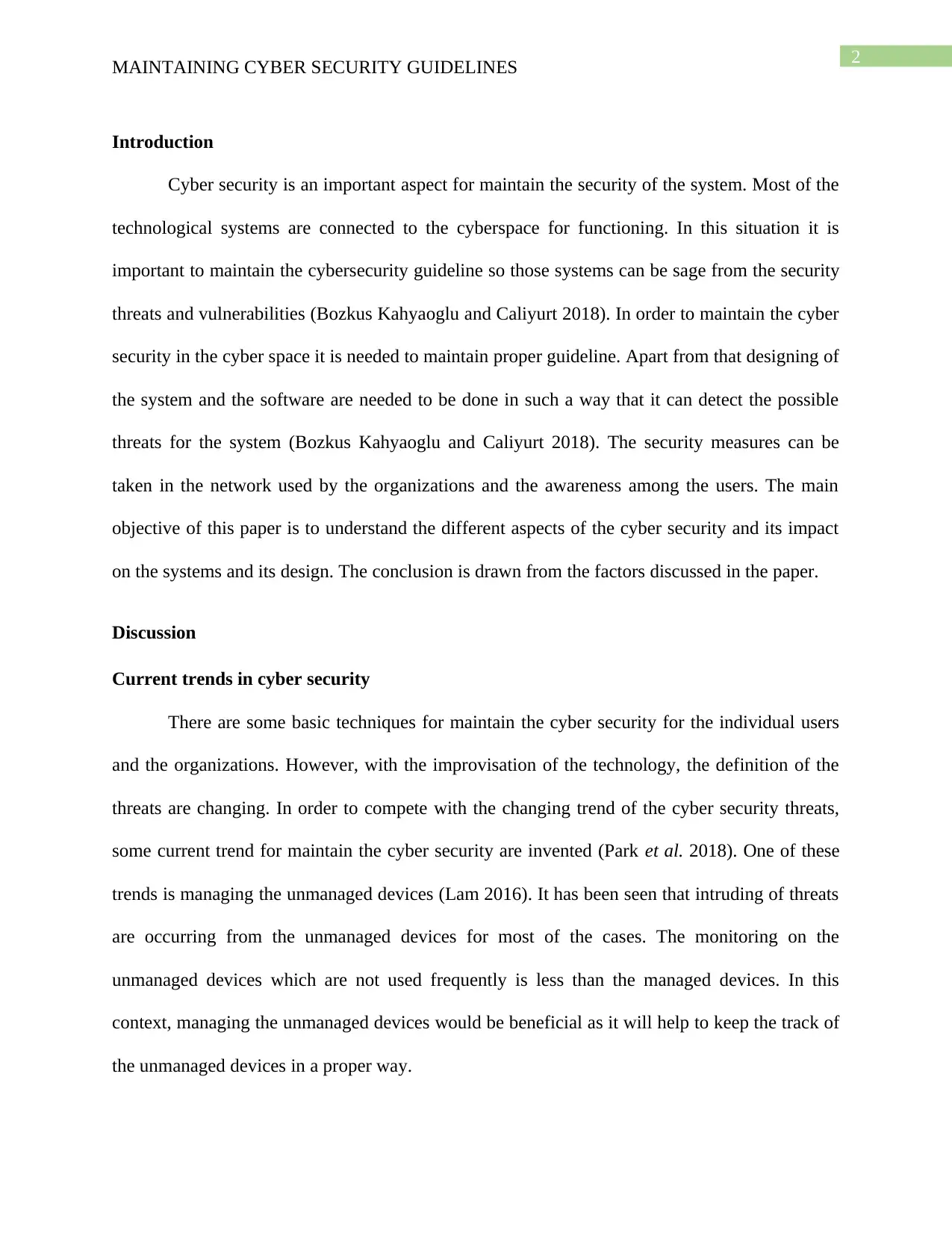
2
MAINTAINING CYBER SECURITY GUIDELINES
Introduction
Cyber security is an important aspect for maintain the security of the system. Most of the
technological systems are connected to the cyberspace for functioning. In this situation it is
important to maintain the cybersecurity guideline so those systems can be sage from the security
threats and vulnerabilities (Bozkus Kahyaoglu and Caliyurt 2018). In order to maintain the cyber
security in the cyber space it is needed to maintain proper guideline. Apart from that designing of
the system and the software are needed to be done in such a way that it can detect the possible
threats for the system (Bozkus Kahyaoglu and Caliyurt 2018). The security measures can be
taken in the network used by the organizations and the awareness among the users. The main
objective of this paper is to understand the different aspects of the cyber security and its impact
on the systems and its design. The conclusion is drawn from the factors discussed in the paper.
Discussion
Current trends in cyber security
There are some basic techniques for maintain the cyber security for the individual users
and the organizations. However, with the improvisation of the technology, the definition of the
threats are changing. In order to compete with the changing trend of the cyber security threats,
some current trend for maintain the cyber security are invented (Park et al. 2018). One of these
trends is managing the unmanaged devices (Lam 2016). It has been seen that intruding of threats
are occurring from the unmanaged devices for most of the cases. The monitoring on the
unmanaged devices which are not used frequently is less than the managed devices. In this
context, managing the unmanaged devices would be beneficial as it will help to keep the track of
the unmanaged devices in a proper way.
MAINTAINING CYBER SECURITY GUIDELINES
Introduction
Cyber security is an important aspect for maintain the security of the system. Most of the
technological systems are connected to the cyberspace for functioning. In this situation it is
important to maintain the cybersecurity guideline so those systems can be sage from the security
threats and vulnerabilities (Bozkus Kahyaoglu and Caliyurt 2018). In order to maintain the cyber
security in the cyber space it is needed to maintain proper guideline. Apart from that designing of
the system and the software are needed to be done in such a way that it can detect the possible
threats for the system (Bozkus Kahyaoglu and Caliyurt 2018). The security measures can be
taken in the network used by the organizations and the awareness among the users. The main
objective of this paper is to understand the different aspects of the cyber security and its impact
on the systems and its design. The conclusion is drawn from the factors discussed in the paper.
Discussion
Current trends in cyber security
There are some basic techniques for maintain the cyber security for the individual users
and the organizations. However, with the improvisation of the technology, the definition of the
threats are changing. In order to compete with the changing trend of the cyber security threats,
some current trend for maintain the cyber security are invented (Park et al. 2018). One of these
trends is managing the unmanaged devices (Lam 2016). It has been seen that intruding of threats
are occurring from the unmanaged devices for most of the cases. The monitoring on the
unmanaged devices which are not used frequently is less than the managed devices. In this
context, managing the unmanaged devices would be beneficial as it will help to keep the track of
the unmanaged devices in a proper way.
⊘ This is a preview!⊘
Do you want full access?
Subscribe today to unlock all pages.

Trusted by 1+ million students worldwide
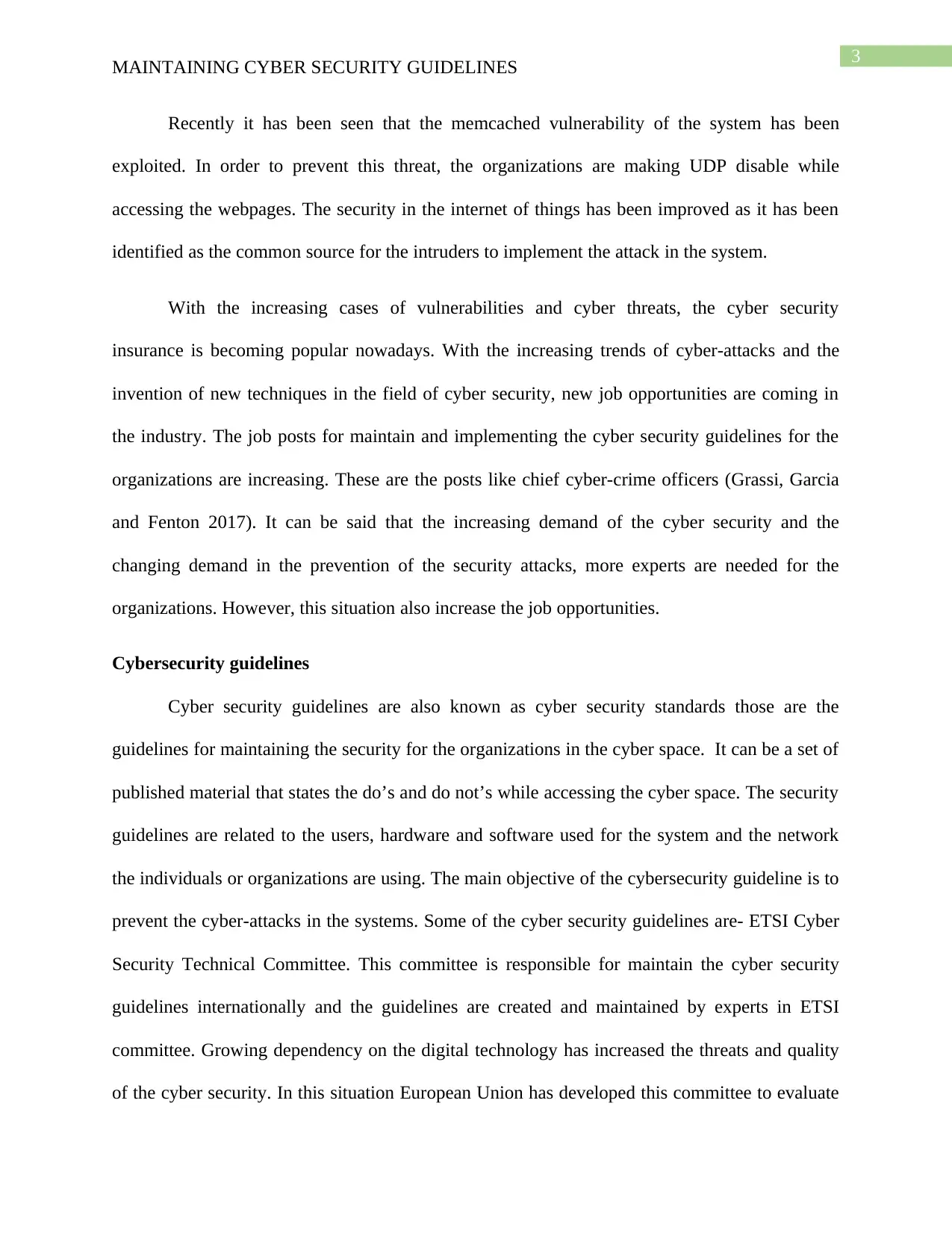
3
MAINTAINING CYBER SECURITY GUIDELINES
Recently it has been seen that the memcached vulnerability of the system has been
exploited. In order to prevent this threat, the organizations are making UDP disable while
accessing the webpages. The security in the internet of things has been improved as it has been
identified as the common source for the intruders to implement the attack in the system.
With the increasing cases of vulnerabilities and cyber threats, the cyber security
insurance is becoming popular nowadays. With the increasing trends of cyber-attacks and the
invention of new techniques in the field of cyber security, new job opportunities are coming in
the industry. The job posts for maintain and implementing the cyber security guidelines for the
organizations are increasing. These are the posts like chief cyber-crime officers (Grassi, Garcia
and Fenton 2017). It can be said that the increasing demand of the cyber security and the
changing demand in the prevention of the security attacks, more experts are needed for the
organizations. However, this situation also increase the job opportunities.
Cybersecurity guidelines
Cyber security guidelines are also known as cyber security standards those are the
guidelines for maintaining the security for the organizations in the cyber space. It can be a set of
published material that states the do’s and do not’s while accessing the cyber space. The security
guidelines are related to the users, hardware and software used for the system and the network
the individuals or organizations are using. The main objective of the cybersecurity guideline is to
prevent the cyber-attacks in the systems. Some of the cyber security guidelines are- ETSI Cyber
Security Technical Committee. This committee is responsible for maintain the cyber security
guidelines internationally and the guidelines are created and maintained by experts in ETSI
committee. Growing dependency on the digital technology has increased the threats and quality
of the cyber security. In this situation European Union has developed this committee to evaluate
MAINTAINING CYBER SECURITY GUIDELINES
Recently it has been seen that the memcached vulnerability of the system has been
exploited. In order to prevent this threat, the organizations are making UDP disable while
accessing the webpages. The security in the internet of things has been improved as it has been
identified as the common source for the intruders to implement the attack in the system.
With the increasing cases of vulnerabilities and cyber threats, the cyber security
insurance is becoming popular nowadays. With the increasing trends of cyber-attacks and the
invention of new techniques in the field of cyber security, new job opportunities are coming in
the industry. The job posts for maintain and implementing the cyber security guidelines for the
organizations are increasing. These are the posts like chief cyber-crime officers (Grassi, Garcia
and Fenton 2017). It can be said that the increasing demand of the cyber security and the
changing demand in the prevention of the security attacks, more experts are needed for the
organizations. However, this situation also increase the job opportunities.
Cybersecurity guidelines
Cyber security guidelines are also known as cyber security standards those are the
guidelines for maintaining the security for the organizations in the cyber space. It can be a set of
published material that states the do’s and do not’s while accessing the cyber space. The security
guidelines are related to the users, hardware and software used for the system and the network
the individuals or organizations are using. The main objective of the cybersecurity guideline is to
prevent the cyber-attacks in the systems. Some of the cyber security guidelines are- ETSI Cyber
Security Technical Committee. This committee is responsible for maintain the cyber security
guidelines internationally and the guidelines are created and maintained by experts in ETSI
committee. Growing dependency on the digital technology has increased the threats and quality
of the cyber security. In this situation European Union has developed this committee to evaluate
Paraphrase This Document
Need a fresh take? Get an instant paraphrase of this document with our AI Paraphraser
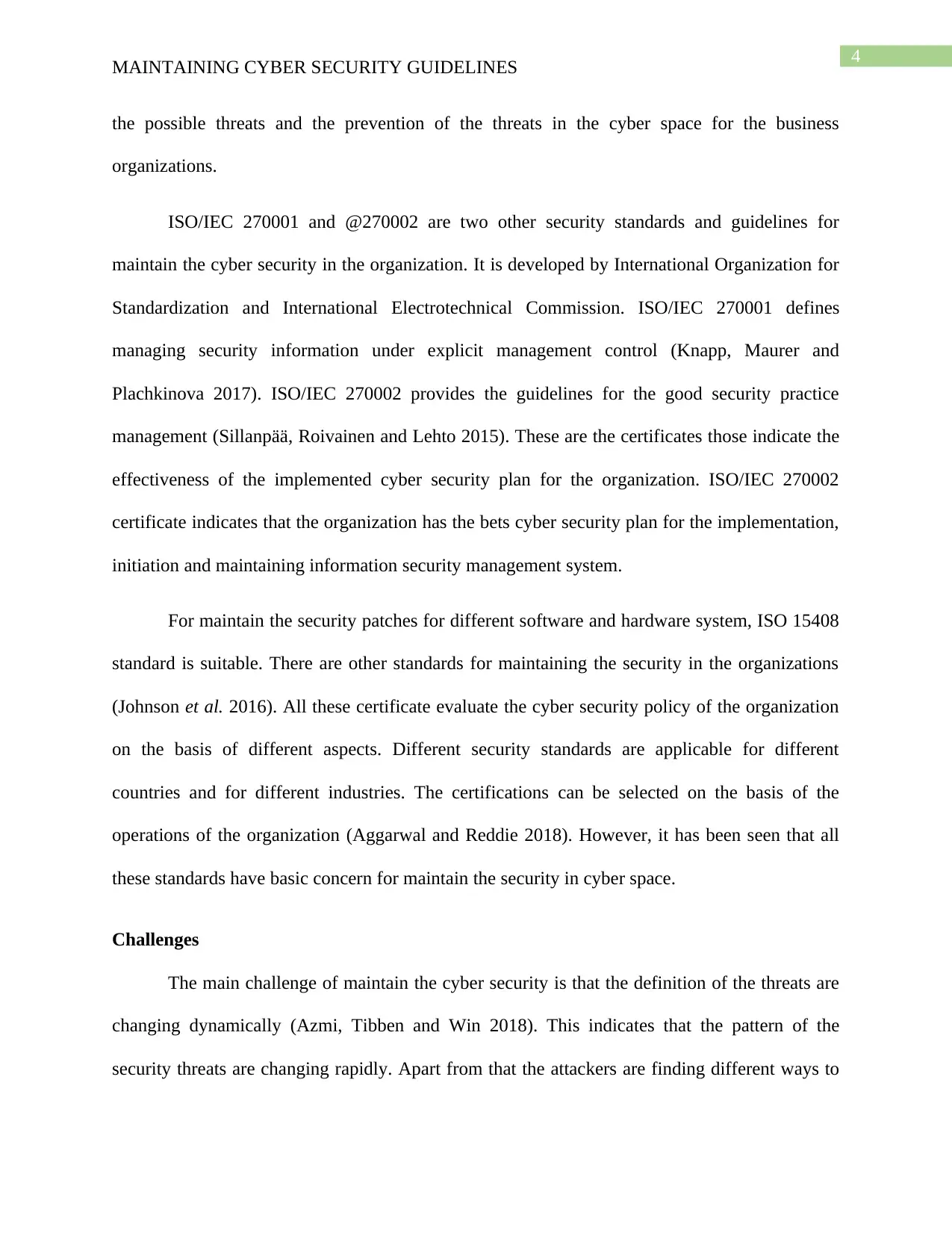
4
MAINTAINING CYBER SECURITY GUIDELINES
the possible threats and the prevention of the threats in the cyber space for the business
organizations.
ISO/IEC 270001 and @270002 are two other security standards and guidelines for
maintain the cyber security in the organization. It is developed by International Organization for
Standardization and International Electrotechnical Commission. ISO/IEC 270001 defines
managing security information under explicit management control (Knapp, Maurer and
Plachkinova 2017). ISO/IEC 270002 provides the guidelines for the good security practice
management (Sillanpää, Roivainen and Lehto 2015). These are the certificates those indicate the
effectiveness of the implemented cyber security plan for the organization. ISO/IEC 270002
certificate indicates that the organization has the bets cyber security plan for the implementation,
initiation and maintaining information security management system.
For maintain the security patches for different software and hardware system, ISO 15408
standard is suitable. There are other standards for maintaining the security in the organizations
(Johnson et al. 2016). All these certificate evaluate the cyber security policy of the organization
on the basis of different aspects. Different security standards are applicable for different
countries and for different industries. The certifications can be selected on the basis of the
operations of the organization (Aggarwal and Reddie 2018). However, it has been seen that all
these standards have basic concern for maintain the security in cyber space.
Challenges
The main challenge of maintain the cyber security is that the definition of the threats are
changing dynamically (Azmi, Tibben and Win 2018). This indicates that the pattern of the
security threats are changing rapidly. Apart from that the attackers are finding different ways to
MAINTAINING CYBER SECURITY GUIDELINES
the possible threats and the prevention of the threats in the cyber space for the business
organizations.
ISO/IEC 270001 and @270002 are two other security standards and guidelines for
maintain the cyber security in the organization. It is developed by International Organization for
Standardization and International Electrotechnical Commission. ISO/IEC 270001 defines
managing security information under explicit management control (Knapp, Maurer and
Plachkinova 2017). ISO/IEC 270002 provides the guidelines for the good security practice
management (Sillanpää, Roivainen and Lehto 2015). These are the certificates those indicate the
effectiveness of the implemented cyber security plan for the organization. ISO/IEC 270002
certificate indicates that the organization has the bets cyber security plan for the implementation,
initiation and maintaining information security management system.
For maintain the security patches for different software and hardware system, ISO 15408
standard is suitable. There are other standards for maintaining the security in the organizations
(Johnson et al. 2016). All these certificate evaluate the cyber security policy of the organization
on the basis of different aspects. Different security standards are applicable for different
countries and for different industries. The certifications can be selected on the basis of the
operations of the organization (Aggarwal and Reddie 2018). However, it has been seen that all
these standards have basic concern for maintain the security in cyber space.
Challenges
The main challenge of maintain the cyber security is that the definition of the threats are
changing dynamically (Azmi, Tibben and Win 2018). This indicates that the pattern of the
security threats are changing rapidly. Apart from that the attackers are finding different ways to
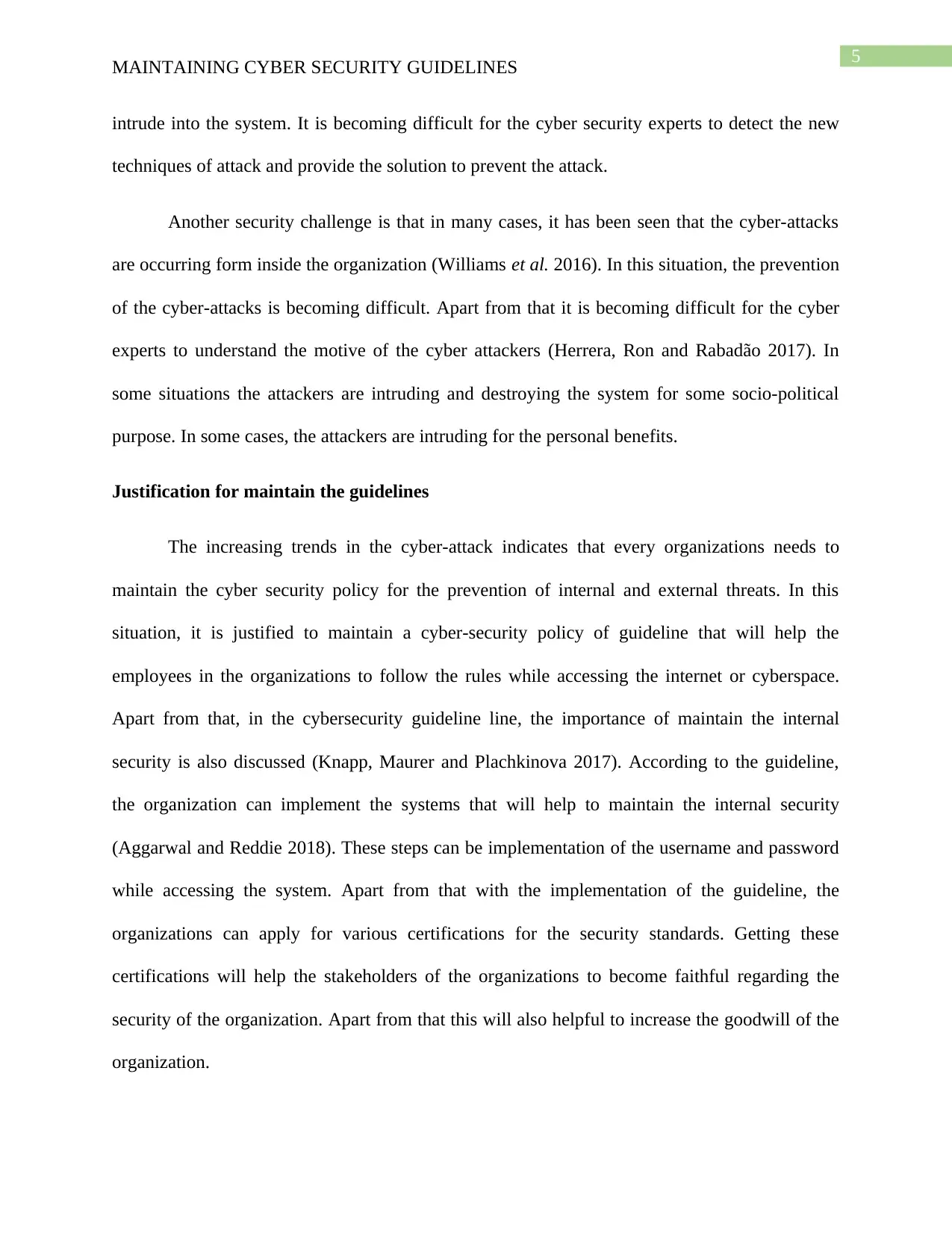
5
MAINTAINING CYBER SECURITY GUIDELINES
intrude into the system. It is becoming difficult for the cyber security experts to detect the new
techniques of attack and provide the solution to prevent the attack.
Another security challenge is that in many cases, it has been seen that the cyber-attacks
are occurring form inside the organization (Williams et al. 2016). In this situation, the prevention
of the cyber-attacks is becoming difficult. Apart from that it is becoming difficult for the cyber
experts to understand the motive of the cyber attackers (Herrera, Ron and Rabadão 2017). In
some situations the attackers are intruding and destroying the system for some socio-political
purpose. In some cases, the attackers are intruding for the personal benefits.
Justification for maintain the guidelines
The increasing trends in the cyber-attack indicates that every organizations needs to
maintain the cyber security policy for the prevention of internal and external threats. In this
situation, it is justified to maintain a cyber-security policy of guideline that will help the
employees in the organizations to follow the rules while accessing the internet or cyberspace.
Apart from that, in the cybersecurity guideline line, the importance of maintain the internal
security is also discussed (Knapp, Maurer and Plachkinova 2017). According to the guideline,
the organization can implement the systems that will help to maintain the internal security
(Aggarwal and Reddie 2018). These steps can be implementation of the username and password
while accessing the system. Apart from that with the implementation of the guideline, the
organizations can apply for various certifications for the security standards. Getting these
certifications will help the stakeholders of the organizations to become faithful regarding the
security of the organization. Apart from that this will also helpful to increase the goodwill of the
organization.
MAINTAINING CYBER SECURITY GUIDELINES
intrude into the system. It is becoming difficult for the cyber security experts to detect the new
techniques of attack and provide the solution to prevent the attack.
Another security challenge is that in many cases, it has been seen that the cyber-attacks
are occurring form inside the organization (Williams et al. 2016). In this situation, the prevention
of the cyber-attacks is becoming difficult. Apart from that it is becoming difficult for the cyber
experts to understand the motive of the cyber attackers (Herrera, Ron and Rabadão 2017). In
some situations the attackers are intruding and destroying the system for some socio-political
purpose. In some cases, the attackers are intruding for the personal benefits.
Justification for maintain the guidelines
The increasing trends in the cyber-attack indicates that every organizations needs to
maintain the cyber security policy for the prevention of internal and external threats. In this
situation, it is justified to maintain a cyber-security policy of guideline that will help the
employees in the organizations to follow the rules while accessing the internet or cyberspace.
Apart from that, in the cybersecurity guideline line, the importance of maintain the internal
security is also discussed (Knapp, Maurer and Plachkinova 2017). According to the guideline,
the organization can implement the systems that will help to maintain the internal security
(Aggarwal and Reddie 2018). These steps can be implementation of the username and password
while accessing the system. Apart from that with the implementation of the guideline, the
organizations can apply for various certifications for the security standards. Getting these
certifications will help the stakeholders of the organizations to become faithful regarding the
security of the organization. Apart from that this will also helpful to increase the goodwill of the
organization.
⊘ This is a preview!⊘
Do you want full access?
Subscribe today to unlock all pages.

Trusted by 1+ million students worldwide
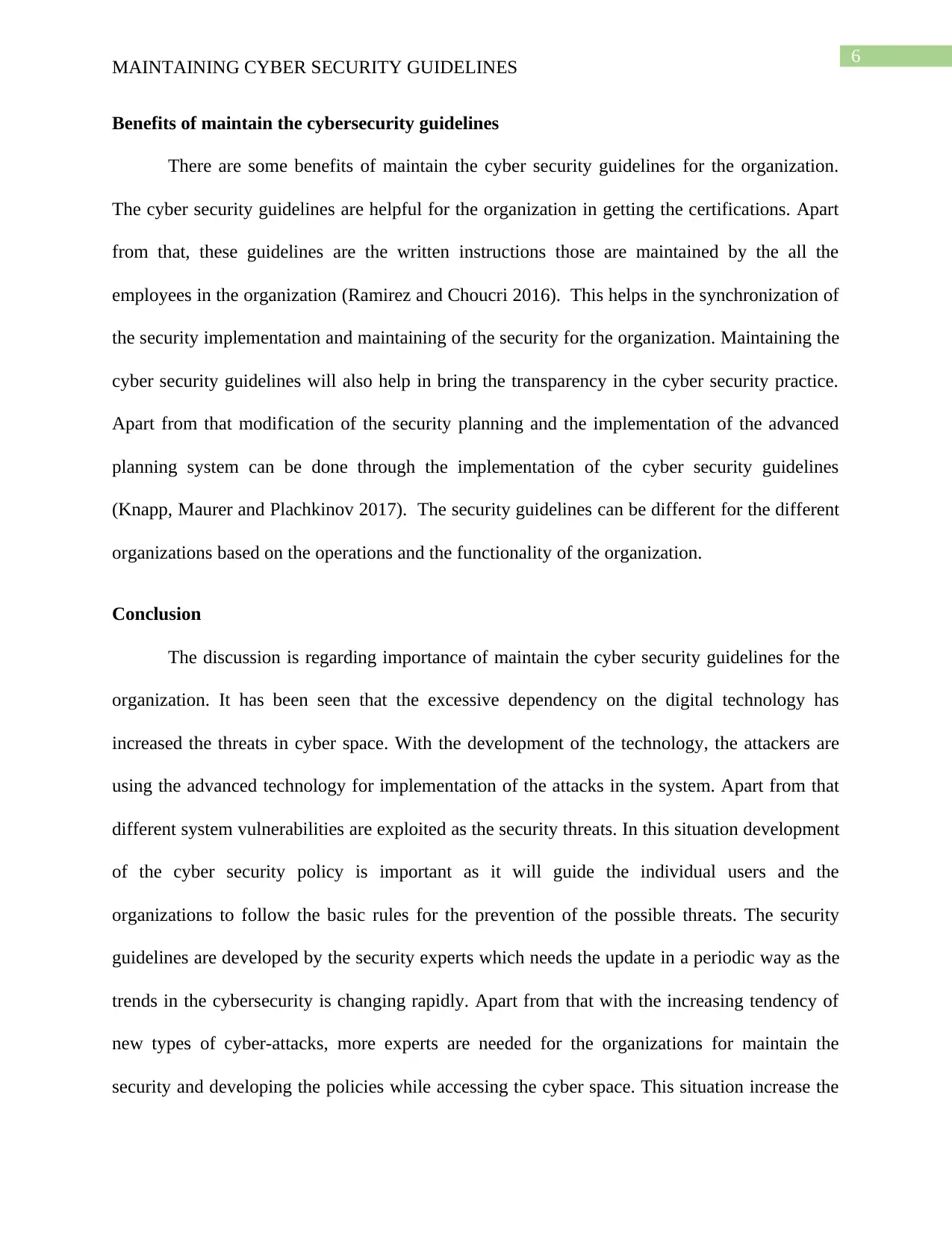
6
MAINTAINING CYBER SECURITY GUIDELINES
Benefits of maintain the cybersecurity guidelines
There are some benefits of maintain the cyber security guidelines for the organization.
The cyber security guidelines are helpful for the organization in getting the certifications. Apart
from that, these guidelines are the written instructions those are maintained by the all the
employees in the organization (Ramirez and Choucri 2016). This helps in the synchronization of
the security implementation and maintaining of the security for the organization. Maintaining the
cyber security guidelines will also help in bring the transparency in the cyber security practice.
Apart from that modification of the security planning and the implementation of the advanced
planning system can be done through the implementation of the cyber security guidelines
(Knapp, Maurer and Plachkinov 2017). The security guidelines can be different for the different
organizations based on the operations and the functionality of the organization.
Conclusion
The discussion is regarding importance of maintain the cyber security guidelines for the
organization. It has been seen that the excessive dependency on the digital technology has
increased the threats in cyber space. With the development of the technology, the attackers are
using the advanced technology for implementation of the attacks in the system. Apart from that
different system vulnerabilities are exploited as the security threats. In this situation development
of the cyber security policy is important as it will guide the individual users and the
organizations to follow the basic rules for the prevention of the possible threats. The security
guidelines are developed by the security experts which needs the update in a periodic way as the
trends in the cybersecurity is changing rapidly. Apart from that with the increasing tendency of
new types of cyber-attacks, more experts are needed for the organizations for maintain the
security and developing the policies while accessing the cyber space. This situation increase the
MAINTAINING CYBER SECURITY GUIDELINES
Benefits of maintain the cybersecurity guidelines
There are some benefits of maintain the cyber security guidelines for the organization.
The cyber security guidelines are helpful for the organization in getting the certifications. Apart
from that, these guidelines are the written instructions those are maintained by the all the
employees in the organization (Ramirez and Choucri 2016). This helps in the synchronization of
the security implementation and maintaining of the security for the organization. Maintaining the
cyber security guidelines will also help in bring the transparency in the cyber security practice.
Apart from that modification of the security planning and the implementation of the advanced
planning system can be done through the implementation of the cyber security guidelines
(Knapp, Maurer and Plachkinov 2017). The security guidelines can be different for the different
organizations based on the operations and the functionality of the organization.
Conclusion
The discussion is regarding importance of maintain the cyber security guidelines for the
organization. It has been seen that the excessive dependency on the digital technology has
increased the threats in cyber space. With the development of the technology, the attackers are
using the advanced technology for implementation of the attacks in the system. Apart from that
different system vulnerabilities are exploited as the security threats. In this situation development
of the cyber security policy is important as it will guide the individual users and the
organizations to follow the basic rules for the prevention of the possible threats. The security
guidelines are developed by the security experts which needs the update in a periodic way as the
trends in the cybersecurity is changing rapidly. Apart from that with the increasing tendency of
new types of cyber-attacks, more experts are needed for the organizations for maintain the
security and developing the policies while accessing the cyber space. This situation increase the
Paraphrase This Document
Need a fresh take? Get an instant paraphrase of this document with our AI Paraphraser
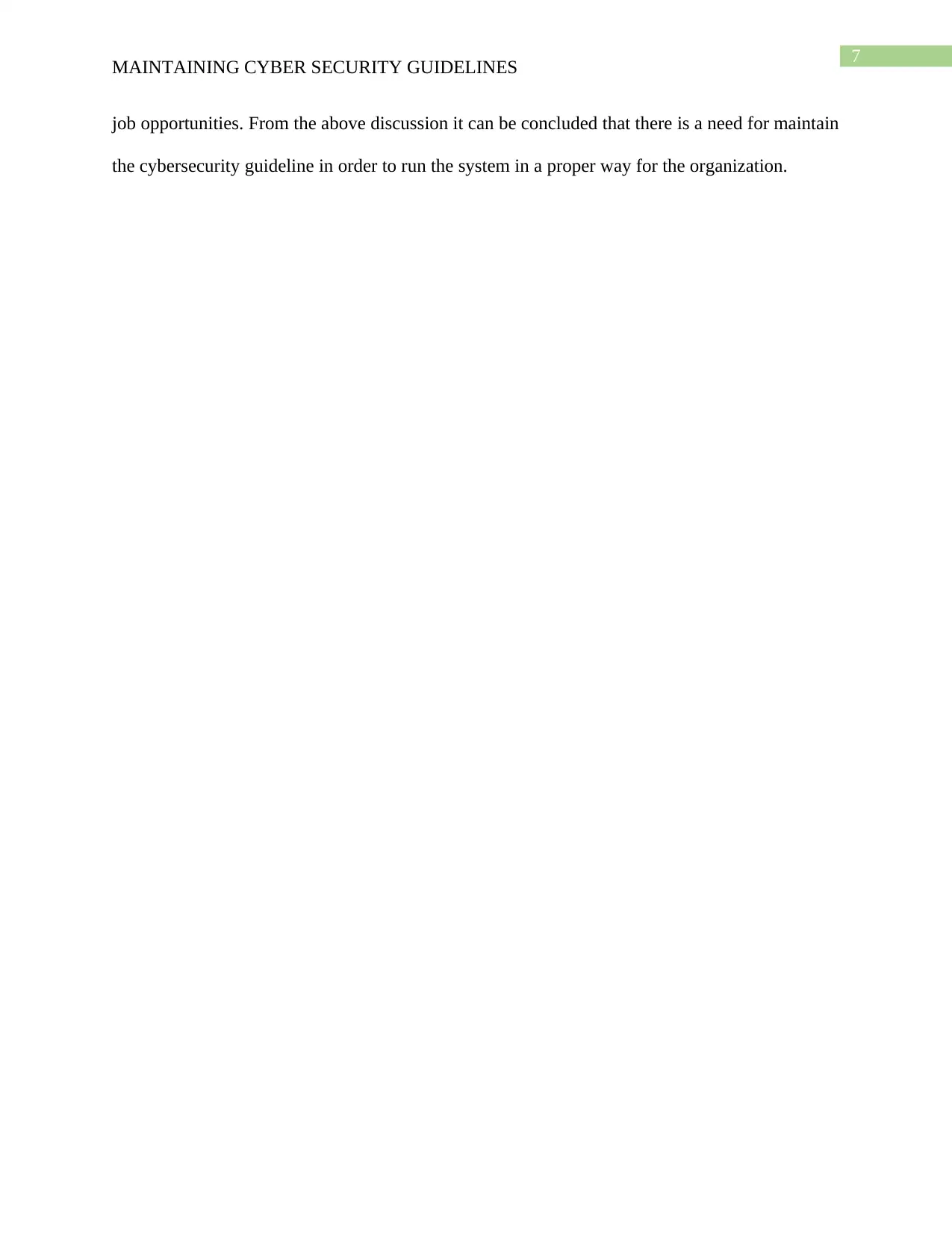
7
MAINTAINING CYBER SECURITY GUIDELINES
job opportunities. From the above discussion it can be concluded that there is a need for maintain
the cybersecurity guideline in order to run the system in a proper way for the organization.
MAINTAINING CYBER SECURITY GUIDELINES
job opportunities. From the above discussion it can be concluded that there is a need for maintain
the cybersecurity guideline in order to run the system in a proper way for the organization.
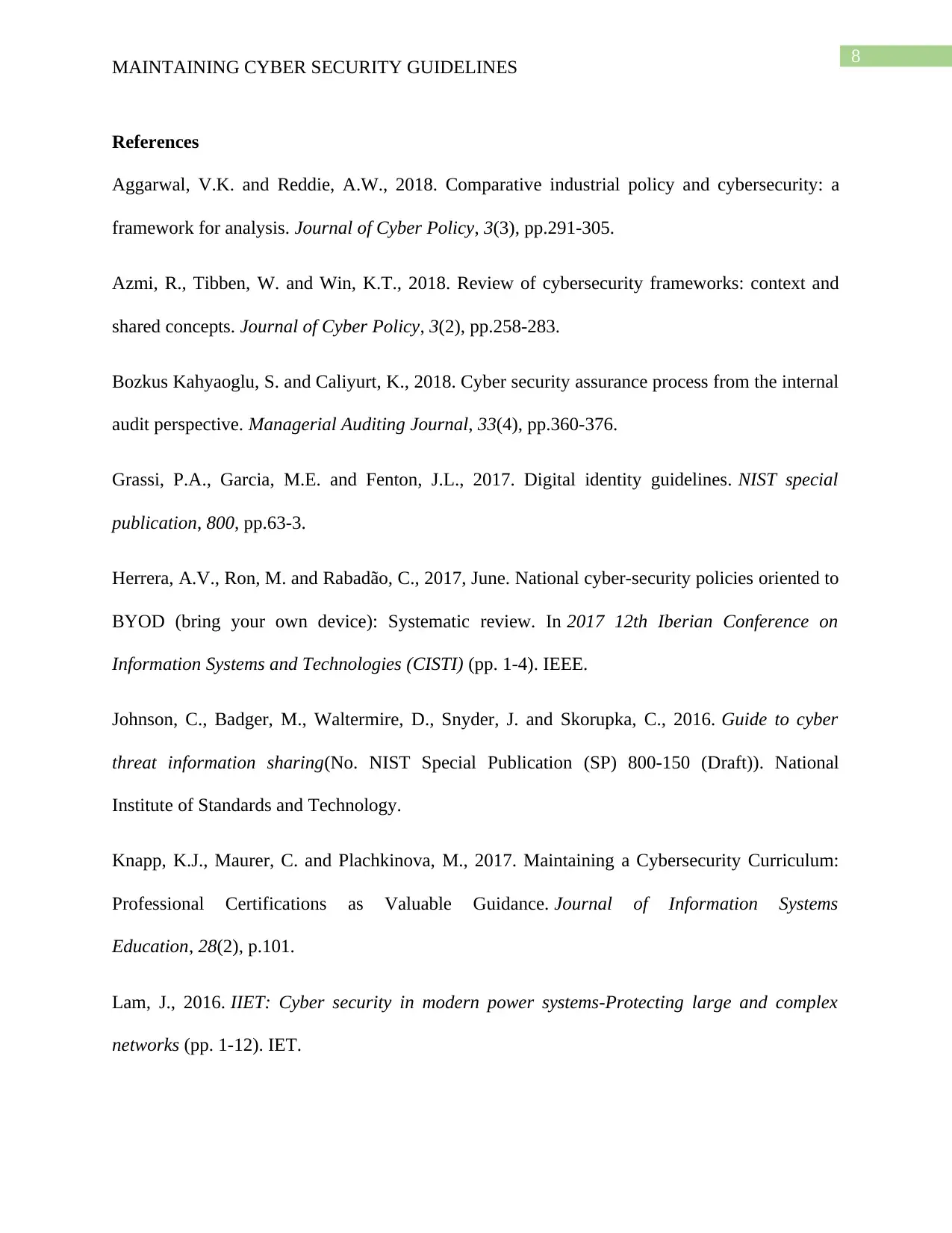
8
MAINTAINING CYBER SECURITY GUIDELINES
References
Aggarwal, V.K. and Reddie, A.W., 2018. Comparative industrial policy and cybersecurity: a
framework for analysis. Journal of Cyber Policy, 3(3), pp.291-305.
Azmi, R., Tibben, W. and Win, K.T., 2018. Review of cybersecurity frameworks: context and
shared concepts. Journal of Cyber Policy, 3(2), pp.258-283.
Bozkus Kahyaoglu, S. and Caliyurt, K., 2018. Cyber security assurance process from the internal
audit perspective. Managerial Auditing Journal, 33(4), pp.360-376.
Grassi, P.A., Garcia, M.E. and Fenton, J.L., 2017. Digital identity guidelines. NIST special
publication, 800, pp.63-3.
Herrera, A.V., Ron, M. and Rabadão, C., 2017, June. National cyber-security policies oriented to
BYOD (bring your own device): Systematic review. In 2017 12th Iberian Conference on
Information Systems and Technologies (CISTI) (pp. 1-4). IEEE.
Johnson, C., Badger, M., Waltermire, D., Snyder, J. and Skorupka, C., 2016. Guide to cyber
threat information sharing(No. NIST Special Publication (SP) 800-150 (Draft)). National
Institute of Standards and Technology.
Knapp, K.J., Maurer, C. and Plachkinova, M., 2017. Maintaining a Cybersecurity Curriculum:
Professional Certifications as Valuable Guidance. Journal of Information Systems
Education, 28(2), p.101.
Lam, J., 2016. IIET: Cyber security in modern power systems-Protecting large and complex
networks (pp. 1-12). IET.
MAINTAINING CYBER SECURITY GUIDELINES
References
Aggarwal, V.K. and Reddie, A.W., 2018. Comparative industrial policy and cybersecurity: a
framework for analysis. Journal of Cyber Policy, 3(3), pp.291-305.
Azmi, R., Tibben, W. and Win, K.T., 2018. Review of cybersecurity frameworks: context and
shared concepts. Journal of Cyber Policy, 3(2), pp.258-283.
Bozkus Kahyaoglu, S. and Caliyurt, K., 2018. Cyber security assurance process from the internal
audit perspective. Managerial Auditing Journal, 33(4), pp.360-376.
Grassi, P.A., Garcia, M.E. and Fenton, J.L., 2017. Digital identity guidelines. NIST special
publication, 800, pp.63-3.
Herrera, A.V., Ron, M. and Rabadão, C., 2017, June. National cyber-security policies oriented to
BYOD (bring your own device): Systematic review. In 2017 12th Iberian Conference on
Information Systems and Technologies (CISTI) (pp. 1-4). IEEE.
Johnson, C., Badger, M., Waltermire, D., Snyder, J. and Skorupka, C., 2016. Guide to cyber
threat information sharing(No. NIST Special Publication (SP) 800-150 (Draft)). National
Institute of Standards and Technology.
Knapp, K.J., Maurer, C. and Plachkinova, M., 2017. Maintaining a Cybersecurity Curriculum:
Professional Certifications as Valuable Guidance. Journal of Information Systems
Education, 28(2), p.101.
Lam, J., 2016. IIET: Cyber security in modern power systems-Protecting large and complex
networks (pp. 1-12). IET.
⊘ This is a preview!⊘
Do you want full access?
Subscribe today to unlock all pages.

Trusted by 1+ million students worldwide
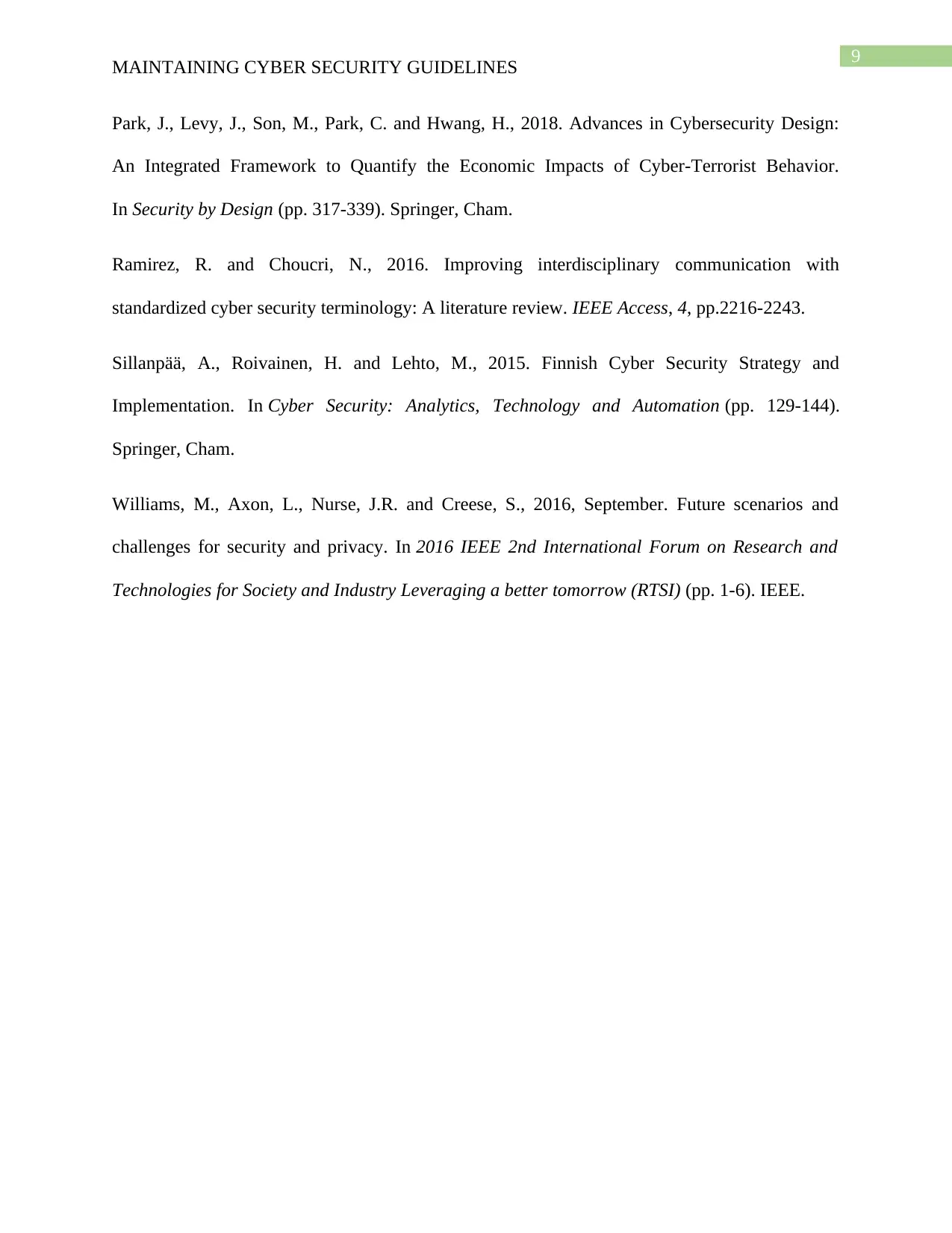
9
MAINTAINING CYBER SECURITY GUIDELINES
Park, J., Levy, J., Son, M., Park, C. and Hwang, H., 2018. Advances in Cybersecurity Design:
An Integrated Framework to Quantify the Economic Impacts of Cyber-Terrorist Behavior.
In Security by Design (pp. 317-339). Springer, Cham.
Ramirez, R. and Choucri, N., 2016. Improving interdisciplinary communication with
standardized cyber security terminology: A literature review. IEEE Access, 4, pp.2216-2243.
Sillanpää, A., Roivainen, H. and Lehto, M., 2015. Finnish Cyber Security Strategy and
Implementation. In Cyber Security: Analytics, Technology and Automation (pp. 129-144).
Springer, Cham.
Williams, M., Axon, L., Nurse, J.R. and Creese, S., 2016, September. Future scenarios and
challenges for security and privacy. In 2016 IEEE 2nd International Forum on Research and
Technologies for Society and Industry Leveraging a better tomorrow (RTSI) (pp. 1-6). IEEE.
MAINTAINING CYBER SECURITY GUIDELINES
Park, J., Levy, J., Son, M., Park, C. and Hwang, H., 2018. Advances in Cybersecurity Design:
An Integrated Framework to Quantify the Economic Impacts of Cyber-Terrorist Behavior.
In Security by Design (pp. 317-339). Springer, Cham.
Ramirez, R. and Choucri, N., 2016. Improving interdisciplinary communication with
standardized cyber security terminology: A literature review. IEEE Access, 4, pp.2216-2243.
Sillanpää, A., Roivainen, H. and Lehto, M., 2015. Finnish Cyber Security Strategy and
Implementation. In Cyber Security: Analytics, Technology and Automation (pp. 129-144).
Springer, Cham.
Williams, M., Axon, L., Nurse, J.R. and Creese, S., 2016, September. Future scenarios and
challenges for security and privacy. In 2016 IEEE 2nd International Forum on Research and
Technologies for Society and Industry Leveraging a better tomorrow (RTSI) (pp. 1-6). IEEE.
1 out of 10
Related Documents
Your All-in-One AI-Powered Toolkit for Academic Success.
+13062052269
info@desklib.com
Available 24*7 on WhatsApp / Email
![[object Object]](/_next/static/media/star-bottom.7253800d.svg)
Unlock your academic potential
Copyright © 2020–2025 A2Z Services. All Rights Reserved. Developed and managed by ZUCOL.



